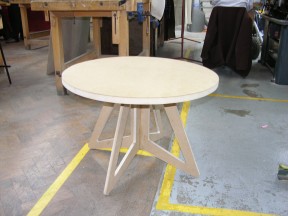Working with fibreboard
Why MDF is a versatile and inexpensive building material
Solid wood isn’t always the best material for woodworking. The proof? Medium-density fibreboard. Commonly called MDF, this very fine-grained sheet material is an inexpensive alternative to solid wood and veneered plywoods. This stuff is cheap-approximately $30 for a 3?4″ x 4′ x 8′ sheet-and dimensionally stable. It saws and routs crisply and takes paint better than any other wood-based material. MDF can even be milled down to specific thicknesses using a benchtop thickness planer. It’s ideal for both paint-grade projects and temporary design mock-ups. And since it’s made of small, fast-growing tree species, MDF is also easier on forest resources than solid wood. While MDF has a lot going for it, this material also has unique weaknesses. MDF is made of ultra-fine wood particles derived from low-grade forest resources held together with glue. It’s composition means it generates a lot of dust when it’s cut and routed. The dust is finer and more harmful than most dust generated in your shop. If your tablesaw and router don’t have effective dust collection built-in, take advantage of summer weather to do your messiest milling work outdoors. Even then, wear a mask.
Another thing you must take into account when working with MDF is grain structure. Of course, this material doesn’t have annual growth rings as real wood does, but MDF is much more prone to splitting along its edges than across its face. This feature means you need to take extra care when driving nails and screws into edges of MDF for joinery. Predrill screw holes generously, and don’t use nails larger than 18 gauge when driving into edges. Got an edge that splits despite your precautions? It’ll show up as a swelling near the nail or screw, but fixing this flaw is easy.
Take the joint apart and redrive the offending fastener into the MDF so it reopens the split and allows you to see it. Next, apply glue into the open crack, remove the fastener, then clamp the repair together tightly before wiping off the excess glue. You’ll find that the gap closes amazingly well. When the glue has dried completely, attempt the assembly again, but only after enlarging your pilot hole.
MDF doesn’t change shape significantly with seasonal humidity shifts, and this makes it well suited for use as panels in painted raised panel doors and wainscoting. But unlike solid-wood designs, MDF panels should be fully glued within stiles and rails, not left free floating, especially in a project in which you’ll be applying light-coloured paint. If panels are free to move, cracks in the paint will appear along the joint line, leaving an obvious and ugly flaw.
The edges of MDF are thirstier than the face surfaces, and this thirst needs to be slaked before a proper finish can build to form smooth results. Although several coats of extra finish onto edges before applying finish to the entire project, this process isn’t ideal. MDF edges are more porous because the grain structure is open here. Because of their absorptive nature, edges and routed profiles need to be sealed before finishing. For this task, you can’t beat a smear of ordinary drywall compound. It’s thick enough to fill the surface, yet thin enough to work into intricate routed details without clogging. Just rub some compound into all edges with your finger, then let it dry completely. When it comes time to sand away the hardened excess, drywall compound happily comes off with 120- or 150-grit paper.
Even if you seal MDF edges properly, you’ll still need to coat the entire project with primer before you paint. Latex paint works well for final coats (sanding between coats with 220-grit paper), but you should only use solvent-based primers initially. When they come in to contact with water-based primers, the surface fibres of MDF swell more than those of wood, which causes unnecessary roughness that’s hard to remove.
Despite its humble appearances, MDF can yield stunning results at low cost and with a modest environmental impact. Try it yourself and see.
Jump to a section
- Page 1 : Versatile MDF can be an inexpensive option for your projects
- Page 2 : Quick Fix for Split MDF Edges
To leave a comment, please log in












No comments